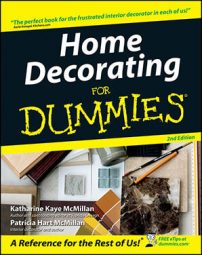A few no-nos
Some strong social conventions do exist. Following are a few no-nos:-
Don’t hang nude paintings in your living room or dining room — it’s inappropriate. Beauties au naturel are naughty-but-nice for bedrooms and bathrooms.
-
Traditionally, fruit or vegetable still lifes are for dining rooms and kitchens not bedrooms or living rooms.
-
Don’t hang family photos or too many wedding photos in the living room. Opt for portraits instead.
-
Never hang religious art in the bathroom; save it for the bedroom or its own niche.
-
Don’t hang small landscape paintings near large still life fruits or vegetables. The disparate scales of the two paintings make both of them look ridiculous.
-
Barnyard scenes are foul in a formal living room, but fair in the den.
-
Don’t hang blood-and-guts war scenes in the dining room.
Floral subjects are usually considered feminine, boats and seascapes masculine, and whimsical themes childish. Feel free to take advantage of this traditional thinking to make quick, easy, and uncontroversial choices.
Ideas for experimenting
If you have an educated eye, you may want to go beyond traditional thinking. At least do some experimenting — most shops make that possible by permitting you to return and exchange art that didn’t work out as you thought it would.Discuss the possibility of exchanging your art at the time of purchase, keep your receipt, and return the art by the store’s deadline in like-new condition.
Look at how professional curators, interior designers, and others hang various kinds of art. Visit museums, galleries, showcase houses, and furniture and department stores with room settings that include art. Browsing through decorating magazines is an inexpensive and time-saving alternative.Woodcuts, etchings, and lithographs
A good starting point when finding the proper setting for your art is to look at what’s worked in the past. For example, each of the various graphic media woodcuts, etchings, and lithographs have characteristics that are compatible with certain decorating periods and styles:-
Woodcuts have a rustic, naive quality that fits with Renaissance, Gothic, and Early American décor. Some make a nice counterpoint to Contemporary furnishings.
-
Etchings are composed of finely drawn lines that are elegant and get along well in dressy rooms.
-
Lithographs are more painterly and colorful and take on a wide range of looks and styles, ranging from romantically Impressionistic to boldly Modern.
Reaching for the eclectic
Contemporary interiors stress individual approaches to very personal rooms where just about anything goes. Some eclectic ideas follow.-
Create interest by contrasting a large, important, period-looking artwork with a crisp, modern background.
-
Pit boldly colored, extremely geometric subjects against stark white walls in rooms furnished with wildly colored furniture.
-
Create art walls, which mix a diverse group of works in interiors where all other furnishings are subdued and play second fiddle to the art.

